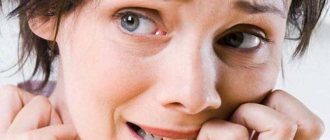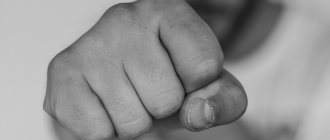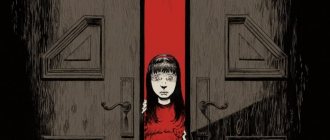Human phobias: classification according to Karvasarsky
For convenience, we will sort phobias/fears alphabetically. The tables provide a list of all human phobias.
| Name of fear | What is a person afraid of? |
| Ablutophobia | Swim |
| Aviation phobia | Fly by the plane |
| Agoraphobia | Large open spaces, squares |
| Aquaphobia | Water |
| Acrophobia | Feeling afraid of heights |
| Alginophobia | Pain |
| Amnesiphobia | Lose your memory |
| Androphobia | Fear of men and intimacy with them |
| Ankylophobia | Fear occurs when thinking about immobility |
| Anthophobia | Anxiety or panic at the sight of flowers |
| Asthenophobia | Weaknesses |
| Atazagoraphobia | Forget something |
| Autophobia | Be left without a spouse |
| Automysophobia | Get dirty |
| Ballistophobia | Pul |
| Bathophobia | Locations in multi-storey buildings |
| Bibliophobia | Libraries |
| Blatophobia | Beetles and cockroaches |
| Bogiphobia | Everything otherworldly and mystical |
| Vaccinophobia | Vaccines |
| Venerophobia | Venereal diseases |
| Vertigophobia | Dizziness |
| Wiccaphobia | Magic, witchcraft rituals and everything connected with them |
| Vinophobia | Wine drinks and their use |
| Virginityphobia | Rape |
| Gamaxophobia | Transport on wheels |
| Gamophobia | Bonds of marriage (women's marriage, men's marriage |
| Gatophobia | Cats (domestic only) |
| Hedonophobia | Pleasant sensations, joyful feeling |
| Hematophobia | Blood (panic so severe that the person may lose consciousness) |
| Gerascophobia | Old age |
| Herpetophobia | Serpent |
| Heterophobia | Representatives of the opposite sex |
| Hydrargiophobia | Substances containing mercury |
| Hylophobia | wooded area |
| Hypegiaphobia | Responsibility for something |
| Hypnophobia | Hypnosis |
| Hippophobia | Horses |
| Gnosiophobia | New knowledge |
| Hodophobia | Panic fear of traveling |
| Homophobia | Manifests itself in fear (even hatred) of homosexuals |
| Gravidophobia | Pregnancy and pregnant women |
| Dementophobia | Lose my mind |
| Demonophobia | Otherworldly evil spirits |
| Dentophobia | Dental procedures |
| Decidophobia | Making independent decisions |
| Diabetophobia | Diabetes mellitus |
| Dikephobia | Justice |
| Dysmorphorbia | Your appearance |
| Dorophobia | Give something |
| Euresiphobia | Ideas that do not coincide with public opinion |
| Eupophobia | Positive news |
| Zeusophobia | Panic at the thought of deity |
| Zoophobia | General name for fear of animals, which is divided into many varieties |
| Iatrophobia | Medical institutions |
| Isopterophobia | Insects |
| Intimofia | Sexual intimacy (especially the first) |
| Iophobia | Get poisoned by poisons |
| Hypochondria | Any illness |
| Ichthyophobia | Fear of fish |
| Kairophobia | Everything new (people, things, events) |
| Cacophobia | Blows, beatings |
| Cancerophobia | Get sick with cancer |
| Cardiophobia | Cardiovascular diseases |
| Keirophobia | Injuries during hairdressing procedures |
| Kinophobia | Dogs |
| Kyphophobia | Slouching, hunch on the back |
| Claustrophobia | Panic fear of enclosed spaces |
| Cleisiophobia | Thieves, robberies |
| Cnidophobia | Fear and aversion to all varieties of insects |
| Koinophobia | Fear of crowded rooms |
| Coimetrophobia | Panic at the sight of cemeteries |
| Cometophobia | Space objects and events |
| Countertophobia | Harassment |
| Copophobia | Loss of strength |
| Spacephobia | Space objects |
| Cryophobia | Cold |
| Xerophobia | Dry weather |
| Xyrophobia | Shaving machines |
| Kumpunophobia | A very rare pathology that manifests itself as panic at the sight of buttons |
| Khorophobia | Dance |
| Laliophobia | Talk |
| Lachanophobia | Eat vegetables |
| Leukophobia | White |
| Ligrophobia | darkness |
| Lissophobia | Development of mental disorders |
| Louisphobia | Get sick with syphilis |
| Lutraphobia | Otters |
| Macrophobia | Waiting (especially long) |
| Maleusiophobia | Give birth to |
| Megalophobia | Volumetric objects |
| Honeyphobia | Jellyfish |
| Mesophobia | Infectious pathologies |
| Meningitophobia | Development of brain diseases |
| Methylophobia | Alcoholic drinks |
| Mechanophobia | Road transport |
| Microphobia | Small items |
| Morphinophobia | Morphine addiction |
| Musophobia | Mice |
| Necrophobia | Funeral rites, corpses |
| Neophobia | Everything new |
| Nosocomephobia | Medical institutions |
| Numerophobia | Numbers |
| Obesophobia | Overweight |
| Oikophobia | Lose my mind |
| Olfactophobia | Smells |
| Oocytophobia | eggs |
| Ornithophobia | Birds |
| Papyrophobia | Fear of paper, paper objects |
| Paralipophobia | Take a wrong action |
| Parapophobia | Doing your duty |
| Parthenophobia | Virgins |
| Patroyophobia | Diseases transmitted by inheritance |
| Peiraphobia | To speak, to give a speech in front of an audience |
| Pyrophobia | Fire |
| Plakophobia | Mogil |
| Potilitikophobia | Politicians |
| Proctophobia | Development of proctitis |
| Psychophobia | Mentally ill people |
| Pteronophobia | Bird feathers |
| Radiophobia | Radiation influence |
| Ritiphobia | Appearance of wrinkles |
| Russophobia | Total Russian |
| Selaphobia | Sveta |
| Silensophobia | Silence |
| Sinophobia | Total Chinese |
| Sitiophobia | Eat food |
| Scotomaphobia | Blindness |
| Sophophobia | Learn something new |
| Social phobia | Being in society |
| Speedophobia | AIDS |
| Staurophobia | Krestov |
| Stenophobia | Too narrow rooms |
| Suicidophobia | Committing suicide |
| Thalassophobia | Large expanse of water (sea, ocean) |
| Thanatophobia | End of life |
| Taphephobia | Buried alive |
| Teniophobia | Worm infections |
| Thermophobia | Heat, high temperature |
| Tomophobia | Wild horror before surgery |
| Traumatophobia | Damage, wounds, traumatic situations |
| Tredecaphobia | Numbers 13 |
| Tuberculosisphobia | Infection and development of tuberculosis |
| Uranophobia | Raya |
| Urinophobia | Perform the process of urination |
| Chairophobia | Pleasant, joyful feelings |
| Hoplophobia | Knives and other sharp objects |
| Cenophobia | Empty rooms, empty space |
| Cyclophobia | Bicycle transport |
| Eichophobia | Best wishes, good luck |
| Eleuterophobia | Freedom (to the point of disgust) |
| Electrophobia | Sockets, electricity |
| Enissophobia | Critics addressed to you |
| Enosiophobia | Committing a sin |
| Ercinophobia | Incomprehensible works |
| Ephebiophobia | Teenagers |
| Jatrophobia | Medical personnel |
These tables provide lists and meanings of common phobias. But in fact, there are much more of them, which once again proves the prevalence of mental illnesses in our time.
We have already figured out what kind of phobias a person has. Now let's look at the most common of them. In psychiatry, there are about 10 fears that clients of psychotherapists most often encounter. Let's look at the list of the most common phobias and their meaning.
- Panic in front of closed spaces, called claustrophobia in psychiatry.
- Horror at the sight of the dead and funeral rituals, which is called necrophobia.
- An insurmountable fear of air travel is aerophobia.
- Horror in dark places or rooms. - nyctophobia.
- The fear of being at heights is acrophobia. People with this pathology experience horror when going upstairs. They cannot walk in the mountains or simply stand on a stool.
- Panic at the sight of spiders is arachnophobia. This pathology is one of the most common types of zoophobia.
- A strong fear of dentists and dental procedures is dentophobia. Such people refuse treatment, even if the dental situation is critical.
- Fear of snakes is ophidiophobia. As a rule, everyone is afraid of reptiles, but in ophidiophobes this fear is obsessive. They refuse to visit pet stores, zoos and other places where snakes may live.
- Panic that develops in a person at the sight of blood is hemophobia. The horror can be so strong that a hemophobe can lose consciousness at the sight of blood.
- Another common type of fear is cynophobia, when a person is terrified of dogs.
The list of human phobias that occur most often has recently been supplemented by cancerophobia - the fear of getting cancer. This is partly due to the increase in cancer on the planet. More and more clients are turning to psychotherapists to free themselves from obsessive thoughts about a malignant disease.
Celebrities are no less likely, if not more likely, than ordinary people to be afraid. Fear of something can reach the point of absurdity. Let's consider what fears stars have.
- Nicole Kidman experiences wild horror at the sight of butterflies. Interestingly, cockroaches and mice do not evoke any emotions in the star.
- Uma Thurman suffers from claustrophobia, which she developed after filming a film where she had to lie in a coffin. Now the actress is afraid of elevators and enclosed spaces.
- Orlando Bloom is famous for his fear of pigs. His pathology also developed as a result of filming the film. The big boar escaped from the cage and rushed after the actor.
- Oprah Winfrey can't stand chewing gum. Her fear comes from childhood, when her grandmother frightened her as a little girl with punishment at school for chewing. The fear turned out to be so strong that it haunts the celebrity to this day.
- Scarlett Johansson is terribly afraid of birds. The actress developed a fear of birds as a result of filming the film “We Bought a Zoo,” during which a peacock broke free, thereby frightening the star.
People's fears are endless, and celebrities are no exception. You can live peacefully with many of them, while some are very poisonous and require specialized help.
| Types of phobias | Examples |
| Panic in front of society, when a person can’t bear to be among people, it’s impossible to tolerate criticism | This classification includes fear of large crowds of people, public speaking, new acquaintances, the opposite sex, etc. |
| Phobias/fear of harming yourself or others | Fear of infection, injury (hence panic in front of sharp objects), fear of committing suicide, or harming others |
| Phobias that are associated with movement in space | This includes fear of riding public transport, fear of heights, closed and open spaces, and much more. |
| Fear of getting sick, contracting an unpleasant disease | Fear of oncology, sexually transmitted and other diseases |
| Fear of doing something bad to yourself or others | Fear of using obscene language or behaving badly in public |
| Fears related to the intimate sphere | Panic before sex, fear of getting pregnant, giving birth |
| Fears associated with one's own death | Most often people are afraid of being buried alive |
| Secondary fears that develop against the background of fear due to an existing phobia | If the phobia is not treated, additional pathologies will develop over time, requiring more serious treatment. |
We reviewed the list of types of human phobias according to Karvasarsky. This is the main classification used in psychiatric practice. But there are other types of fears.
Speaking about the types of phobias, it is important to note that they are divided into primary and secondary. The list of primary phobias is long, we reviewed it above. If, for example, a person is afraid of flying on an airplane, his fear is called aerophobia. It refers to the primary pathology. But when it is joined by other disorders on its own background, we are talking about a secondary deviation. Additionally, for example, fear of heights or closed spaces may develop.
Psychotherapy
The optimal way to work with aichmophobia. Firstly, there is no chemical interference in the body’s vital functions, and secondly, a lasting result. Cognitive behavioral therapy works successfully with fear of sharp objects. The method by which the main correction of this phobia is carried out (in addition to working through negative experiences) is systematic desensitization.
Oxyphobia is successfully corrected through imagery therapy, as well as through group psychotherapeutic training. In principle, any therapy will give results, but it will take a completely different time. If the fear is not a consequence of PTSD or a third-party incident, then you should not choose long-term treatment methods (if such a possibility exists). The long-term ones can certainly include:
- psychoanalysis;
- existential therapy;
- logotherapy.
Given the fact that oxyphobia, as we have already noted, is to some extent a grotesque form of defensive behavior, one should not expect that the client will become completely fearless before the edge of the knife. Of course, when slicing cheese, you will be calm, but no one guarantees calm in a situation where you are threatened with a knife.
Causes of fear
Objects of aichmophobia include the following items:
- scissors: stationery, kitchen, hairdressing;
- sewing supplies: tools and needles;
- glass, mirrors and glass products (especially broken ones);
- construction equipment: nails, cutlasses, axes, saws, etc.;
- cold steel items: knives, daggers, blades;
- cutlery: forks, knives and pastry utensils.
There are many more different objects that can be the objects of this disease, however, the fear of knives most often arises.
Sometimes the phobia takes such forms that a person may be terribly afraid of cutting himself with a piece of paper and dying. With this pathology, corners on walls, doors and furniture can terrify a person. This may seem funny to some, but for a person suffering from unjustified fear, looking at all these things is sheer torture.
For a person who has encountered something similar in his life, it does not matter how exactly it happened. The important thing is that a loved one died from injury from a sharp object, probably experiencing severe pain. Such a situation could well make a strong impression on the psyche of a person suffering from aichmophobia.
The attempt was unsuccessful, but having experienced physical pain and fear of death, a former suicide may remain forever impressed.
In this case, the victim, unable to recover from the experience, may continue to be afraid of piercing objects even if they no longer pose a threat to his health and life.
An attempted murder may cause the victim to become afraid of sharp objects.
Phobia from childhood
Fear can remain for life if adults constantly frighten the child that with one or another object he can cut himself or get seriously injured. The child, drawing scary pictures in his head, forever imprinted them in his subconscious.
Subsequently, after an injury received with a sharp object in childhood, a pathological fear of the object from interaction with which this injury was received may develop.
It doesn’t matter whether the Aichmophobe himself or someone from his environment suffered in his presence. If a person witnesses an accidental injury, serious injury or even death, then he has a very high chance of developing a panic fear of piercing or cutting objects.
It also happens that a person who suffers from aichmophobia fears not for himself, but for the people around him. A possible reason may be that at the moment of loss of self-control, the patient begins to fear for himself. This case is the most severe, but a very significant reason for the fear of sharp objects.
Treatment methods for aichmophobia
Since such fear is a deep-seated fear that almost always does not have a clear explanation, the most effective way to treat this phobia is hypnosis, which can only be prescribed to you by a psychotherapist to whom you turn for help. It is important to understand that a true professional will never completely rid you of the fear of cuts, since this will threaten your health in the future. It will only dull the level of fear itself, turning it from a panic obsession into the most basic caution characteristic of most normal people.
Alas, it is almost impossible to get rid of aichmophobia . And the ineffectiveness of numerous attempts to do this on your own, analyzed by doctors, proves that there is no other effective method other than the one we described just above.
Related materials:
- There are no similar materials...
Symptoms of pathological fear
Phobia attacks can occur at varying frequencies, from several times a day, or to be absent for several months. The frequency and severity of attacks are influenced by the general psychological state of the patient, his life circumstances, and general health.
Subsequently, social maladjustment and vulnerability sets in. At this time, the instinct of self-preservation is activated, and aggression or hysteria may occur. The patient tries with all his might to avoid contact or mention of a dangerous object. A panic attack may give way to a hysterical attack.
Symptoms of an attack of aichmophobia:
- cardiopalmus;
- acceleration of pulse and breathing;
- tinnitus;
- pale skin and cold sweat;
- fever or suffocation;
- feeling of heaviness and physical discomfort;
- uncontrolled movements of the limbs;
- dizziness;
- desire to run away or hide;
- aggression (indignation) or hysteria.
If there are four or more symptoms when seeing or mentioning sharp objects, we can talk about the presence of aichmophobia.
Symptoms of pathological fear of sharp objects do not bring comfort to the life of either the patient with aichmophobia or those around him, which can have extremely negative consequences of various kinds. This disease requires complex treatment with the involvement of specialists.
During an attack, the patient may experience ringing in the ears
Medicines
They make sense only in severe cases and frequent attacks, as well as when fear is included in the picture of another disease. To reduce the frequency of panic attacks, as well as to create “chemical calm,” a course of tranquilizers is prescribed.
In case of extremely frequent (daily) and severe (up to derealization and loss of consciousness) attacks, “explosive” therapy with tranquilizers can be carried out. The bottom line is that the treatment is carried out over a week and is aimed at suppressing active symptoms, the dosages of the drugs are maximum (however, they are selected individually).
With this treatment, a person is placed in a hospital so that his mental and physical status are always under the control of the treating specialists.
And after the attacks have been suppressed, psychotherapeutic treatment begins. However, maintenance therapy with psychopharmacological substances can last up to six months from the last severe attack. Then the substance is systematically withdrawn. Cancellation also occurs when there are obvious side effects.
Author of the article: Borisov Oleg Vladimirovich, developmental psychologist
Problem
This issue was brought to the attention of Bruce N. Eimer, Ph.D., who is a certified clinical psychologist licensed in Pennsylvania and New Jersey and the author of nine books. He works as a shooting instructor and is a certified member of the NRA. Dr. Eimer has performed thousands of evaluations of security and law enforcement personnel to determine mental fitness to carry a firearm on the job.
His research shows that Hoplophobia is a real, extremely dangerous, widespread, clinically recognizable complex specific phobia that meets most, but not all, of the measures that the American Psychiatric Association and the medical community have chosen for this type of disorder.
Sarah Thompson, M.D., a psychiatrist and former executive director of the Utah Gun Owners Association, believes that hoplophobia is actually a separate category of phobic disorder.











